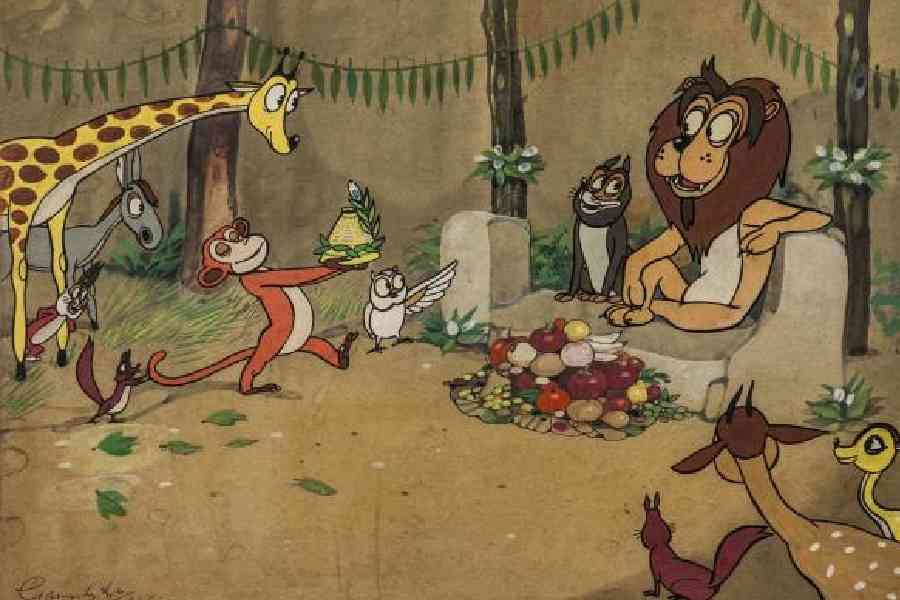The Big Picture: The past, present and future of animation


Commercially, animation started — mainly in advertising and visual effects and titles in feature films — in Mumbai, Chennai, Hydera- bad, Trivandrum and Calcutta, as these are film-producing cities. In the early years, the pioneers were Dadasaheb Phalke, Gunomoy Banerjee, Gokhale and Mandar Mullick, who employed Ganesh Pyne. Later, emerged Bhimsain Khurana, Ram Mohan (1931-2019), V.G. Samant, R.L. Mistry to name a few. Ram Mohan was eventually crowned the Father of Indian Animation. Later came progressive pioneers like Prakash Moorthy, Dhimant Vyas, Srinivas Bhakta, Phani Tetali, Sanjiv Waeerkar, Vaibhav Kumaresh, E. Suresh, Sanath PC, Chetan Sharma and Gayatri Rao, Nina Sabnani, Shilpa Ranade and
Gitanjali Rao.
Before formal education in animation took off at the National Institute of Design (NID) in Ahmedabad in the 1960s and the IIT Bombay Industrial Design Centre (IDC) in Mumbai in the mid-80s, many people started as self-taught animators in the studios of film-producing cities. One good example was the Calcutta-based Chandi Lahiri.
Post-Independence, the Indian government set up the Films Division of India (FDI) in 1948 to promote and document our diverse culture. To increase awareness and tell our own stories, the Cartoon Film Unit was set up as a part of the FDI in 1955. Later, animation in advertisements became popular.
The FDI played a significant role in training and developing Indian talent during the early days. NID, Ahmedabad, began offering animation training
in the 1960s, producing the likes of Ishu Patel. When we consider animation as a medium of story- telling, we can draw parallels
to the use of puppets in traditional storytelling. One of the most popular forms closely
related to animation in India is shadow puppets.
Animation has emerged as a popular career option. It is an industry which is in need of a large workforce of diverse talent, not just storytellers.
The medium of animation has made its way into almost every sector — be it ultra-short or feature-length films, episodic series, advertisements, video games, architectural walk-throughs, medical or defence simulation, live action storyboard, fiction, non-fiction, explainer video, game, interactive, infographics, multimedia performance, merchandising or educational aids.
Here are some tips for aspiring animators based on information provided by Sekhar Mukherjee, programme lead, department of moving image, Anant National University, Ahmedabad; Sanath PC, co-founder, VFX supervisor and creative director at Firefly creative studio in Hyderabad; and Vaibhav Kumaresh, Emmy-nominated animation filmmaker, and founder and creative director at Vaibhav Studios in Mumbai.
Training
Two different kinds of programmes are emerging in animation education. The school of storytelling in the likes of NID, IDC, Shristi Institute of Art, Design and Technology, Maharashtra Institute of Technology and the Satyajit Ray Film and Television Institute. And the school of techniques with the likes of Arena and MAAC.
Qualifications
For most institutions, Plus Two is the basic qualification, and an aptitude test is also to be passed. Essentials are storytelling ability, passion, sincerity, imagination, originality, honesty, curio- sity, willingness to experiment and work hard, and a portfolio of non-copied creativity. A background in fine arts and performing arts is always advantageous. It also depends on what kind of school one is approaching. Some learn as an apprentice in a studio if they prove their worth.
Quality
It was tagged as backend — outsourced work — and copycat nation — little independent work beyond the Disney or Pixar template — when it came to animation. However, owing to good schools like NID and IDC and the few good animation festivals and bodies like Chitrakatha, TASI’s Anifest India, MIFF and now Animela, there is a slow rise in Indian animation cinema. Apart from the US, the example India is now following is the indie
animation culture of the world, like Franco Belgian, Japanese, and Swiss. There is a glimmer of hope. Indigenous animation content creators in India who create films from idea to execution are in a minority. They need to work hard at their storytelling as well as production quality to build a local industry.
Future
It was always an uncertain journey till the IT revolution started an avenue for outsourced studios where animation training became popular. In the aftermath of 9/11, business process outsourcing (BPO), which was on a high, crashlanded.
The pandemic and the advancement of digital platforms were a big boost for animation storytellers to find a foothold alongside spreading awareness of the tremendous potential of animation as a beautiful vehicle.
Companies catering to outsourced projects will continue to depend on their foreign counterparts for business. Content creators need to build a strong local audience by producing local animation content that connects with our audiences. That’s the only way to encourage content creation and consumption — and thereby create a self-sufficient industry.
Animation remains an enduring form of communication, continually adapting and evolving alongside technological advancements. As boundaries between mediums blur, animation will embrace new forms and definitions. With the arrival of AI, it’s a crossroads situation. But it could be exciting.